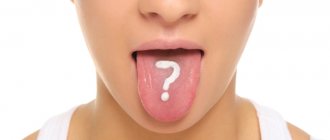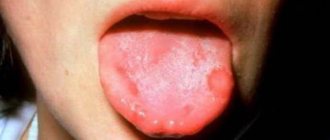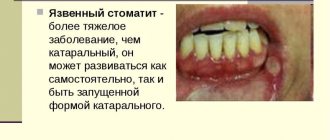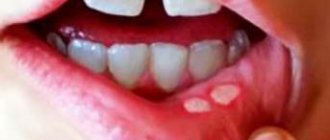Types of disease
According to ICD-10, aphthous stomatitis is assigned code K.12. Within the code there are three qualifying diagnoses, including K.12.0 - “recurrent aphthae of the oral cavity,” which also includes aphthous ulcers.
According to the form of occurrence, acute and chronic aphthous stomatitis are distinguished. The first is characterized by the appearance of ulcers and severe hyperemia - swelling, redness of the mucous membranes. Severe pain occurs, especially when eating or talking. Submandibular lymph nodes may enlarge and body temperature may rise.
Chronic recurrent aphthous stomatitis may be the result of improper or untimely treatment, as well as the inability of the immune system to cope with the disease. It is characterized by periodic exacerbations. Outside of exacerbation, symptoms may be erased or completely absent.
The disease is classified into three forms depending on the severity:
- light. From 1 to 2 afts up to 10 mm in size. Moderate pain during mechanical action, relapses occur no more than 2 times a year;
- average. Up to 5 aft, the course of treatment takes up to 3 weeks. The pain is quite pronounced, there is an enlargement of the lymph nodes, relapses up to 2 times a year;
- heavy. Multiple aphthae appear, severe pain. An increase in temperature occurs, and symptoms of general intoxication appear. Treatment takes up to a month, relapses occur up to 6 times a year.
Also, according to the form of occurrence, the following types of inflammatory diseases are distinguished:
- fibrous: blood microcirculation in the upper layer of the mucosa is disrupted, aphthae appear, covered with a fibrous film (plaque). Such ulcers heal completely within 14 days. The disease affects the mucous membrane of the lips, the lateral surfaces of the tongue, and transitional folds. This stomatitis recurs up to 3 times a year;
- necrotic. The epithelium is destroyed, the mucosal area dies. Replacement of tissues with normal epithelium takes from 14 to 30 days. This aphthous stomatitis is not accompanied by acute pain; it is usually observed in patients with severe diseases, including blood pathologies;
- grandular. Damage to the ducts of the minor salivary glands occurs. In this regard, aphthae form close to the glands, and drying of the mucous membranes of the oral cavity occurs due to a decrease in saliva production. Ulcerations are painful and heal within 1–3 weeks;
- scarring. Damage to the cavity of the salivary glands leads to the involvement of connective tissue in inflammation. Aphthae are observed both at the location of the glands and on the mucous membranes of the pharynx and palate. The disease develops into large painful ulcers (up to 1.5 cm). Healing takes up to 12 weeks; after the acute process, pronounced scars remain;
- deforming. The most severe form of the disease, which provokes changes in connective tissue. Aphthae heal extremely slowly, which is accompanied by deformation of the palate, lips, and sometimes narrowing of the oral cavity occurs (if aphthae was observed in the corners of the mouth).
Ask a Question
Symptoms
The main symptom of chronic aphthous stomatitis is inflammation on the inside of the mouth. The clinical picture is as follows: aphthae usually have a round, spherical shape. Their size is no more than 1 cm. Touching the aphthae causes burning and stinging, so often at the time of exacerbation, children become excessively nervous and capricious.
There are three forms of aphthous stomatitis:
- light;
- medium-heavy;
- heavy.
With a mild form, aphthae appear sporadically several times every 2-3 years, with a moderate form - several aphthae per year. The severe form is characterized by the constant occurrence of painful ulcers in the mouth. Therefore, treatment of stomatitis must begin immediately - after detecting the first signs of the disease.
As for the general condition of the patient, mild and moderate forms do not have a significant effect on the body. But severe chronic aphthous stomatitis can cause another serious disease - regional lymphadenitis (inflammation of the lymph nodes).
Speaking about the tolerance of aphthosis and pain, the patient feels irritating, painful sensations in the oral cavity only during the inflammatory process, that is, immediately after the appearance of aphthosis. What is natural is that the severity of the disease leads to an increase in ulcers and their depth.
Causes of aphthous stomatitis
Not all causes of aphthous stomatitis are fully understood. The mechanism of aft formation is often associated with activation of the local immune system - immune cells begin to destroy the epithelium of the mucous membranes, which leads to ulcers.
Local reasons include the following:
- allergic reactions;
- pathogenic microorganisms;
- mechanical damage (biting mucous membranes, injury from sharp edges of fillings or orthopedic, orthodontic structures);
- temperature or chemical influences.
Systemic causes of aphthous stomatitis:
- menstruation, pregnancy in women;
- sudden cessation of smoking;
- enteropathy, celiac disease, malabsorption;
- blood diseases;
- diseases of the immune system;
- lack of vitamins;
- other systemic diseases (lupus erythematosus, Crohn's disease, HIV infection, etc.).
Causes
The main reason why a person develops aphthous stomatitis is a disruption in the functioning of the body's immune defenses. Many pathogenic microorganisms pass through the oral cavity, but if the immune system is strong, they do not affect the condition in any way and do not cause disease. But in the event of a decrease in immunity, the mucous membrane is one of the first to suffer, so it is dangerous to ignore the signs of pathology or try to cope with the problem on your own.
Other reasons
The presence of a constant source of infection can trigger the disease.
In addition to reducing the immune properties of the body, the trigger mechanism influencing the development of aphthous stomatitis is:
- Dental pathologies: untreated caries;
- inflammation of the gums;
- pulpitis;
- periodontitis.
Symptoms of aphthous stomatitis
Usually, 1–2 days before the appearance of aphthae, areas of the mucous membrane with increased sensitivity are detected, and a burning sensation may occur. The aphthae themselves are round, have clear boundaries, and are covered with a gray or yellowish coating. Their size, as a rule, does not exceed 1 cm, and the mucous membranes around them turn red.
Such areas of erosion heal within up to 2 weeks without scarring. But in 1 case out of 10, the diameter of the ulcers is more than 1 cm, they affect deeper areas of tissue, and the borders of the pathological area may look raised. Healing in this case takes up to 6 weeks, after which a scar forms.
Aphthous stomatitis is characterized by damage to the mucous membranes of the cheeks, the inside of the lips, the soft palate, tonsils, and the lateral surfaces of the tongue. This is due to the lack of keratinization of the epithelium in these areas. Much less often, aphthae appear on the hard palate, back of the tongue, and gums.
Diet, nutrition
Aphthous stomatitis requires adherence to a gentle diet. Eliminate foods with high acid concentrations (for example, citrus fruits) from your diet. Spicy foods are also best consumed after recovery.
Your diet should consist of warm food with a soft consistency. We are talking mainly about natural dairy products and neutral fruit purees. It is better not to fry the remaining products, but to boil or bake in the oven. For stomatitis, it is permissible to consume meat broths, as well as warm jelly. The ideal option for breakfast is oatmeal viscous porridge.
After eating with aphthous stomatitis, you should rinse your mouth with plain water or a decoction of herbs. Please note that after applying the ointments, you should refrain from eating for at least a couple of hours so that the active substances have time to take effect. It is important not to refuse food because of pain, but to follow a proper diet.
Thus, the treatment of aphthous stomatitis is complex.
Diagnostic features
At the initial appointment, the dentist examines the oral cavity and analyzes complaints. To make an accurate diagnosis, you need to distinguish this form of the disease from others, as well as differentiate it from other pathologies that have similar symptoms. For extensive lesions, different diagnostic methods may be used:
- clinical blood tests;
- microflora smear;
- blood for PCR to determine the causative agent of the disease;
- biopsy (if indicated).
They are also necessary for recurrent forms of the disease. In simple cases, laboratory diagnostics are not required; aphthae are determined visually by an experienced specialist.
With the help of a comprehensive examination, the doctor will determine which microorganism caused inflammation with subsequent ulceration of the mucous membrane. He also differentiates the disease from herpetic stomatitis and oncological pathology.
Diagnostics
Differential diagnosis may be required to distinguish stomatitis from other pathologies of the mucous membrane
When the first signs of stomatitis of the palate appear, you should consult a doctor.
The dentist deals with diseases of the oral cavity.
The diagnosis is made in most cases based on a patient interview and examination.
Most often, this is enough to confirm the disease and determine its type.
If in doubt, a test is carried out for candidiasis and herpes, bacterial culture of a scraping or smear.
Differential diagnosis may also be required to distinguish stomatitis from other pathologies of the mucous membrane.
For frequent stomatitis, especially one that is difficult to treat, the dentist may send the patient for a general examination to identify systemic and chronic diseases that are its causes.
Features of treatment
The main goal of treating aphthous stomatitis is to completely get rid of the disease or at least reduce the frequency of relapses to a minimum. Therapy is aimed at relieving inflammation, relieving unpleasant symptoms, and accelerating the recovery processes of the mucous membrane.
For each specific case, the doctor will develop a set of measures. The main ones include local and systemic drug treatment.
Rinsing with antiseptics can be done using medications or mouth rinses that contain antibacterial components. An alternative to rinsing is to use a spray. Typically, the treatment regimen includes 2-3 sessions of 1-minute rinsing immediately after brushing your teeth.
Local treatment methods include the application of gels with anti-inflammatory and analgesic effects.
Occlusive agents can reduce pain and speed up the healing of mucous membranes. They form an insoluble film on the ulcer, protecting the affected area from exposure to adverse factors.
Local glucocorticoid therapy is used against the background of immune diseases, as well as when standard measures are ineffective. They eliminate pain and quickly relieve inflammation, shortening the healing period. Such products are used only according to indications and are available with a prescription. In some cases, it is advisable to inject the drug under the base of the ulcer; this is done by a doctor.
Epithelialization drugs are used after acute inflammation has resolved. The specialist will prescribe a gel with an analgesic and healing effect, usually this occurs 5–6 days after the start of complex therapy.
Local laser therapy can relieve pain, speed up the healing process, and minimize the risk of relapse.
Systemic treatment of aphthous stomatitis in adults involves taking the following drugs:
- antihistamines (anti-allergic, anti-edematous effect);
- glucocorticoids (anti-inflammatory, analgesic effect);
- immunomodulators (to stimulate defenses and accelerate recovery).
And if antiallergic drugs can be recommended to any patient even in the absence of information about the exact causes of stomatitis, then other drugs are prescribed only according to indications: in case of acute severe course of the disease, frequent relapses, and the presence of severe systemic pathologies. An additional method of treatment is vitamin therapy - taking vitamins C, group B.
In addition to the main course of treatment, all patients without exception are recommended to adhere to a hypoallergenic diet, avoid taking too hot drinks and dishes, and spicy, irritating foods. It is better to give preference to toothpaste without sodium lauryl sulfate, this component can provoke the disease.
It is important to continue your oral hygiene, even if it is difficult. To make brushing your teeth easier, choose a soft toothbrush. If the disease recurs frequently, it is necessary to pay attention to the general state of health, promptly treat teeth and gums, replace fillings and dental structures.
Causes
The exact mechanism of aphthous stomatitis has not yet been determined. The main factors causing the development of the disease include the body's immune reactions, exposure to foreign agents, mechanical injuries, and other external or internal factors.
- Immune response . Scientists call the most likely cause of the development of acute aphthous stomatitis a specific reaction of the immune system to certain chemicals.
- Viral and infectious diseases. Ulcerative lesions of the oral mucosa can be caused by viruses and bacteria found in the blood during influenza, measles, sore throat and other diseases.
Chronic recurrent aphthous stomatitis (CRAS) - Diseases of the teeth and oral cavity . Any foci of infection in the mouth (cavities, gingivitis, herpes, etc.) often cause aphthae and other manifestations of stomatitis.
- Mechanical damage . Scratches, burns and other injuries to the mucous membrane are not conducive to oral health and often cause all sorts of diseases.
- Psycho-emotional stress . About 16% of patients associate aphthous stomatitis with nervous and emotional overload.
- Poor nutrition, gastrointestinal lesions . The development of stomatitis is often accompanied by hypovitaminosis of groups A, B, C, as well as a lack of certain microelements and nutrients (folic acid, iron, zinc, selenium), lesions of the gastrointestinal tract, infectious, ulcerative, etc.
Aphthous stomatitis in adults
In childhood, aphthous stomatitis develops more often than in adults, since children have the habit of putting fingers and various objects in their mouths, and the immune system, due to its imperfection, cannot immediately defeat the disease. In adulthood, the disease recurs much more often and becomes chronic.
Causes of aphthous stomatitis
Features of treatment in children
The dentist will tell you how to treat aphthous stomatitis in a child. You can contact him at the direction of your pediatrician or on your own if you find characteristic ulcers in the oral cavity. The treatment regimen is the same as that used in the treatment of adult patients, but there are some differences: children under a certain age cannot rinse the mouth, so preference is given to drugs for application to mucosal ulcers. Otherwise, the treatment regimen is developed individually, taking into account the severity, symptoms of the disease, frequency of relapses, and the presence or absence of concomitant ailments in the child. Symptomatic therapy can be used to quickly alleviate the baby’s condition.
Specialists at STOMA clinics successfully treat aphthous stomatitis. By contacting us, you will receive qualified assistance, detailed recommendations on the treatment and prevention of relapse of the disease, and comprehensive assistance from dentists of all specializations, if necessary.
Classification
Aphthous stomatitis has five varieties: fibrinous, necrotic, cicatricial, granular and deforming, and each of them has its own characteristics of the course.
Table. Classification of aphthous stomatitis.
| Form of the disease | Main reasons | Clinical features |
| Fibrinous | Viral infections, pathological microorganisms | The mildest subtype of aphthous stomatitis. Lesions heal within 1-2 weeks without leaving scars |
| Necrotic | Severe gastrointestinal diseases, blood diseases | Small aphthae, characteristic of stomatitis, gradually turn into ulcers, after which they epithelialize. The process is almost painless and is accompanied by necrotic tissue lesions |
| Grandular | Damage to the salivary glands | Ulcerative defects appear near the salivary glands, are characterized by unpleasant sensations and heal after 1-3 weeks. Subsequently, the appearance of aphthae can cause decreased immunity and respiratory diseases |
| Scarring | Genetic factors (various pathologies of salivation) | Aphthae are located mainly in the area of the pharynx and palate and quickly turn into extensive painful defects. Their healing process is long, about 3 months, after which rough scars remain in the oral cavity |
| Deforming | All of the above reasons | The most severe type of disease, as it is accompanied by serious changes in tissues, which can lead to deformation of the palatal arches |
Symptoms of aphthous stomatitis











